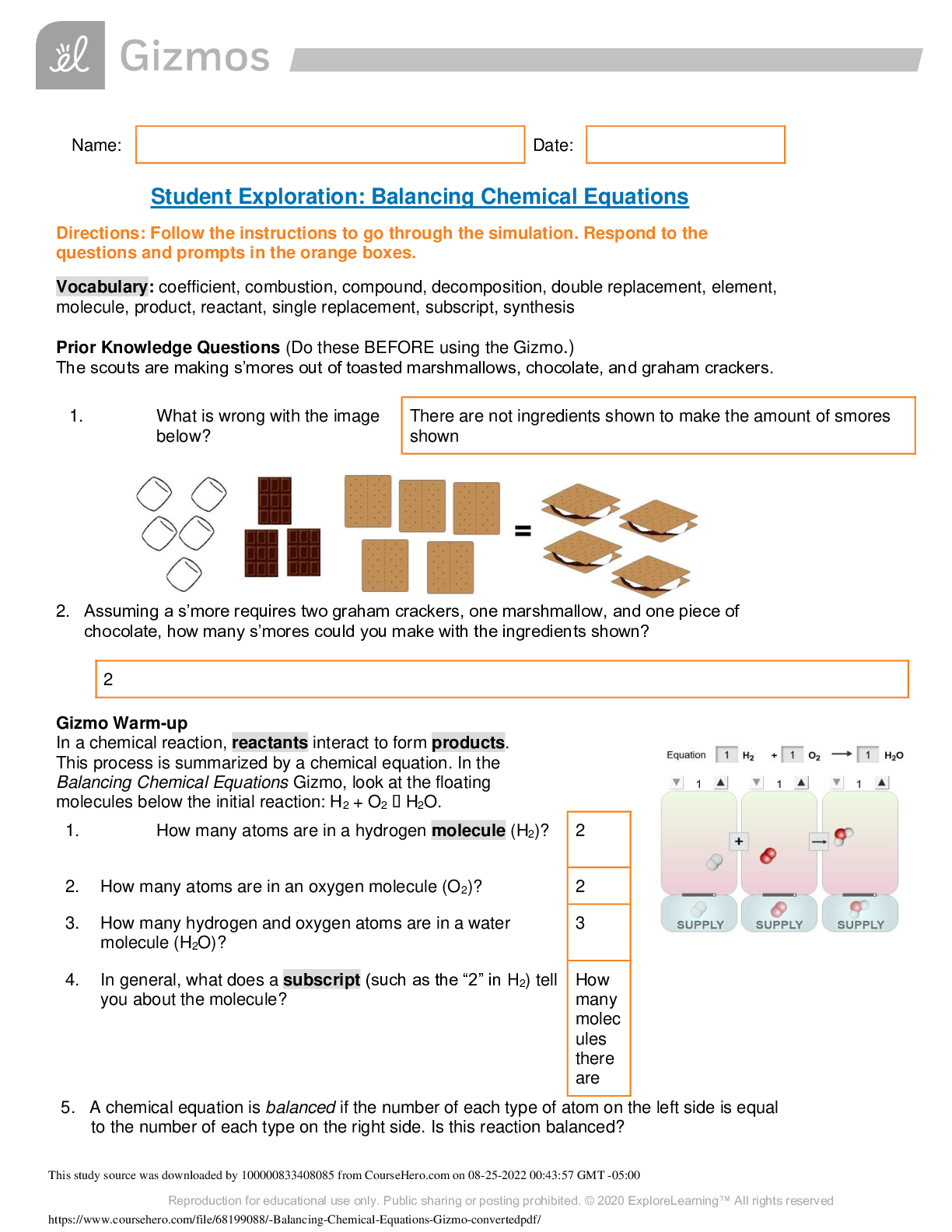
Final_Exam__Principles_of_Programming_Language_saveeeee. Arizona State University CSE 47708
$ 10

Balancing Chemical Equations Gizmo converted | all answers 100% correct | 4 pages
Pathophysiology > EXAM > PATHOPHiSIOLOGY EXAM 2021 WITH CORRECT ANSWERS. PATHOPHiSIOLOGY EXAM DEPARTMENT (All)
Exercise 1 - Writing Activity This exercise will take approximately 20 minutes to complete. Exercise 1 - Question 1 To which categories of lung disease does emphysema belong? Your Answer: It ... is in the chronic obstructive pulmonary disease category. Chronic airflow limitation (CAL) Chronic obstructive pulmonary disease (COPD) Question 2 Not yet graded / 1 pts Exercise 1 - Question 2 Briefly describe the pathophysiology of emphysema. Your Answer: Emphysema is pathologically defined as an abnormal permanent enlargement of air spaces distal to the terminal bronchioles, accompanied by the destruction of alveolar walls and without obvious fibrosis. This process leads to reduced gas exchange, changes in airway dynamics that impair expiratory airflow, and progressive air trapping. Protease enzymes, normally present to destroy and eliminate particles and organisms inhaled during breathing, are present in higher-than-normal levels. They damage the alveoli and small airways by breaking down elastin. The alveolar sacs lose their elasticity and the small airways collapse or narrow. Some alveoli are destroyed and others become large and flabby with decreased area for effective gas exchange. An increased amount of air becomes trapped in the lungs, caused by loss of elastic recoil in the alveolar walls, overstretching and enlargement of the alveoli into air-filled spaces called bullae, and collapse of small airways (bronchioles). These changes greatly increase the work of breathing. The hyperinflated lung flattens the diaphragm, weakening the effect of the muscle. Hence the patient must use accessory muscles (neck, chest wall, and abdomen) to breath. The increased effort increases oxygen demand, making the patient work harder and resulting in an "air hunger" sensation. Gas exchange is also affected by the increased work of breathing and loss of alveolar tissue. Question 3 Not yet graded / 1 pts Exercise 1 - Question 3 Briefly describe the pathophysiology of pneumonia. Your Answer: Pneumonia can be transmitted when airborne microbes from an infected indi-vidual are inhaled by someone else. However, most instances of pneumonia are attributable to self-infection with one or more types of microbes that originate in the nose and mouth. In healthy people, typical upper airway bacterial residents such as Streptococcus pneumoniae (commonly referred to as “pneumococcus”) and Hemophilus influenzae are the most common bacteria causing community-acquired pneumonia. Hospital-acquired pneumonia is usually caused by more resistant bacteria, such as Staphylococcus aureus, Klebsiella pneumoniae, Pseudomonas aeruginosa, and Escherichia coli. Individuals with a serious impairment of their immune system become susceptible to pneumonia caused by so-called “opportunistic” microbes, such as certain fungi, viruses, and bacte-ria related to tuberculosis (mycobacteria), that would not ordinarily cause disease in normal individuals. Pneumonia is an excess of fluid in the lungs resulting from an inflammatory process. The inflammation occurs in the interstitial spaces, the alveoli, and often the bronchioles. The process of pneumonia begins when organisms penetrate the airway mucosa and multiply in the alveolar spaces. White blood cells migrate to the area of infection, causing local capillary leak, edema, and exudate. These fluids collect in and around the alveoli and the alveolar walls thicken. RBCs and fibrin move into the alveoli. The capillary leak spreads the infection to other areas of the lung. The fibrin and edema of inflammation stiffen the lung, causing decreased lung compliance and a decline in the vital capacity. Alveolar collapse (atelectasis) further reduces the ability of the lungs to oxygenate the blood moving through it. As a result, arterial oxygen level fall, causing hypoxemia. Question 4 0.67 / 1 pts Exercise 1 - Question 4 Which are risk factors for community-acquired pneumonia? Select all that apply. Correct! Older adult [Show More]
Last updated: 3 years ago
Preview 1 out of 19 pages

Buy this document to get the full access instantly
Instant Download Access after purchase
Buy NowInstant download
We Accept:


pathophisiology.
By Professor Lynne 4 years ago
$12
5
Can't find what you want? Try our AI powered Search
Connected school, study & course
About the document
Uploaded On
May 28, 2021
Number of pages
19
Written in
All
This document has been written for:
Uploaded
May 28, 2021
Downloads
0
Views
122
Scholarfriends.com Online Platform by Browsegrades Inc. 651N South Broad St, Middletown DE. United States.
We're available through e-mail, Twitter, Facebook, and live chat.
FAQ
Questions? Leave a message!
Copyright © Scholarfriends · High quality services·